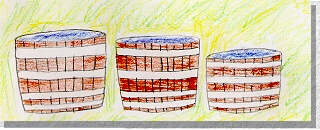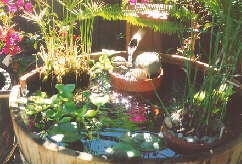

 |
 |
Wooden barrels of various sizes and heights were our choice for our pond because of the small size of our garden. The barrel is a wonderful way to create a pond because of its rustic, natural look, and you can create a great display without having to dig a big hole in your yard or your wallet. However, a container pond does not necessarily have to be a barrel. Good results can be had with containers made of clay or concrete, or even a livestock watering trough. Whatever your choice is, ensure that it is big and deep enough (18"-24") if you plan to support a fish or two. Our pond uses three barrels connected by bamboo pipes and a submersible pump, with each barrel having a special purpose. The largest barrel maintains our premium fish habitat. The middle is a normal-sized wine barrel that was added to increase the total volume of water, and it harbors a couple of fish. The last is used as a sand bio-filter bog to cleanse the water.
Purchasing a recycled half barrel can run you anywhere from $15.00-30.00 or more, depending upon the size, and can be found at at home and garden centers. Once you have a barrel there are three way to prepare it to hold water.
| You
can create a great display without digging a big hole in your yard or your wallet. |
The first step is to carefully select the barrel. If it was sold as a gardening container, it may have a drainage hole cut into the bottom, making it unsatisfactory for use as a pond. If the hole is not too large, you can plug it up with a cork from a wine bottle (I like Champagne best, because of its shape) and then seal it with a bit of clear silicone. When selecting a barrel also check to see that the staves and bottom are tight with no obvious places where water could leak out in copious quantities.
We are lucky to live near the wine country and made a day trip to the cooper's shop to buy our barrel. Since the barrels previously contained wine, there was residue (titrates) clinging to the inside of the barrels, we scraped off as much as possible. (The cooper said this matter made excellent fertilizer, although we haven't tried it yet.) After scraping down the barrels, we filled them with water to swell up the staves and watched as water trickled from the largest barrel. A closer examination revealed a tiny hole in the very bottom (the reason it was for sale to begin with), most likely created by a beetle. We remedied the problem by plugging the hole with a toothpick and a little silicone gel. That did the trick. After letting it set up, we filled the barrel again. There was still a little water loss between the tops of the staves where the barrel had been cut in two (which is to be expected until the staves swell up from the water), but nothing like before. With this in mind, you probably don't want to set up the barrels on top of your heirloom Persian rug in your living room.
 |
We have a concrete patio, so we elevated the barrels by placing both bricks and short lengths of 2x4s beneath them to let the air circulate around them and keep the water insulated from the ground. We learned the hard way that the heat from a concrete patio will turn you pond into bouillabaisse! Even if you were to set the barrels down on soil, we recommend that you elevate them to reduce the risk of the barrel rotting away where it is in contact with the ground. Also, pests would have a harder time climbing up and inside to invade and/or damage your barrel.
Now the fun part, beginning to create you aquatic microcosm in a barrel. It is time to add the water...
[ Top | Barrels | Water | Plants | Fish | Predators | Lynx | Home ]